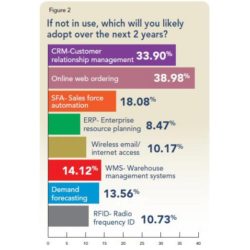Industrial Distribution just came out with the results of their 69th Annual Survey of Distributor Operations. Read their article below:
Survey Of Distributor Operations: Tech Usage & Investments
We’re excited to provide the readers of Industrial Distribution with the results of our 69th Annual Survey Of Distributor Operations. The objectives of this report, as always, have been to understand the most critical issues affecting distributors, and to provide data to help drive their educated business decisions. Through these findings, we’ll discuss new and ongoing industry trends and what trends have fizzled. How has the ongoing industrial recession impacted distributors? Read on to find out.
In this online segment, we focus specifically on Tech Usage & Investments, which covers areas like e-commerce and other big-impact technology solutions for now and the future.
While e-commerce gained traction exponentially with home consumers, it took industrial distributors a little longer to catch on. With so many distributors family-owned and set in their ways after decades and decades of growth, some were reluctant to start selling their products online. Some feared — and still do — that creating an online marketplace for themselves would change customers’ perception of the company. Others got in the game early and have been offering e-commerce for more than a decade.
Given how our survey respondents had previously indicated their e-commerce usage increased in each year this decade so far, some of the results of 2016 came as a surprise. Most prominently, the amount who said e-commerce is a priority — 60 percent — was 9 percentage points lower than a year ago. This comes after a seven-point jump from 2014 to 2015.
This doesn’t appear to be a fluke, as there was a nine-point drop in respondents who said they are currently generating web-based revenues. Adding to this, the amount who said they expect their online sales to increase (Figure 1) had a 6.4-point drop from 2015 to 68.3 percent. Another 30.8 percent of respondents expect this year’s e-commerce sales to stay the same, up 6.3 points from a year earlier. Respondents said there was essentially no change in the percentage of overall sales that are web-generated, with 75.5 percent of them saying e-commerce was responsible for 1 to 10 percent of revenue.
Whether the drop in e-commerce utilization could be tied to the troubling industrial economy conditions is yet to be seen. It’s doubtful that more than a decade of solid e-commerce usage growth would suddenly go backwards out of the blue.
Asked which business technologies they have in use, the number who said they use online web ordering fell four points from last year, also bucking the trend from years past. The technology that saw the biggest gain was in wireless email/internet access, which jumped nearly 11 points from a year ago. Enterprise Resource Planning also had a 9-point gain, while demand forecasting had a 6.6-point decrease. Other technologies that had only marginal changes were Customer Relationship Management (CRM) at 55 percent, Warehouse Management Systems (WMS), Sales Force Automation and Radio Frequency Identification.
For those that don’t use one or more of those technologies, respondents chose online web ordering (39 percent) and CRM (34 percent) as the ones they are most likely to adopt over the next two years (Figure 2). This corresponds with CRM and online web ordering being the technologies respondents chose as having the greatest impact on their business at 36 and 33 percent, respectively.
The amount who said they’ll adopt WMS over the next two years dropped 7 points from last year to 14 percent, while demand forecasting dropped 5.4 points to 13.6 percent. Today’s tech-savvy industrial customer expects a lot of out of websites, and distributors can do a lot with their online offering to help aid potential buyers. Besides an e-commerce element, distributor websites can offer product and services information, support and product reviews. Asked what they primarily use their website for, 50 percent said for housing technical/product information, up 2 points from last year, followed by generating leads (36.7 percent) and generating orders (36.2 percent, down 4 points from 2015). E-commerce (33.9 percent) fell from third to fifth place in this category in 2016.
Customers can quickly be turned off by a website that looks outdated, which is why we ask respondents when their website was last redesigned and how often their website content is updated. The redesign numbers had little change from last year, though there was a 2.5-point increase in the amount who said they can’t recall how long it’s been. Meanwhile, a 5.2-point increase in those who said they update content ‘hardly ever’ is troubling, as is a 3.4-point decrease in the amount who said they update content at least monthly (Figure 3).
Nearly one-third — 31 percent — of respondents said they offer a mobile app for their website, up only .7 points from last year, but a 9-point gain over 2014.
Want to compare this year’s results to last year? See our 2015 survey here.
Methodology
The results of this study are based on an email survey sent to Industrial Distribution subscribers. Recipients of the survey were offered an incentive to complete the questionnaire. Industrial Distribution’s subscriber base is comprised of 30,000 readers, the majority of whom identify as executive, upper management, sales or sales management. Results are based on a pool of respondents within this subscriber base.
Because Industrial Distribution transitioned to a new publisher in 2010, no survey was conducted that year. Therefore, results which track comparisons over the past decade will reflect a gap between 2009 and 2011.
Comments on this year’s results? Email ID’s editor, Mike Hockett, at [email protected]




Comments are closed